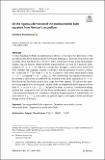On the rigorous derivation of the incompressible Euler equation from Newton’s second law
Author(s)
Rosenzweig, Matthew
Download11005_2023_Article_1630.pdf (499.3Kb)
Publisher with Creative Commons License
Publisher with Creative Commons License
Creative Commons Attribution
Terms of use
Metadata
Show full item recordAbstract
Abstract
A long-standing problem in mathematical physics is the rigorous derivation of the incompressible Euler equation from Newtonian mechanics. Recently, Han-Kwan and Iacobelli (Proc Am Math Soc 149:3045–3061, 2021) showed that in the monokinetic regime, one can directly obtain the Euler equation from a system of N particles interacting in
$${\mathbb {T}}^d$$
T
d
,
$$d\ge 2$$
d
≥
2
, via Newton’s second law through a supercritical mean-field limit. Namely, the coupling constant
$$\lambda $$
λ
in front of the pair potential, which is Coulombic, scales like
$$N^{-\theta }$$
N
-
θ
for some
$$\theta \in (0,1)$$
θ
∈
(
0
,
1
)
, in contrast to the usual mean-field scaling
$$\lambda \sim N^{-1}$$
λ
∼
N
-
1
. Assuming
$$\theta \in (1-\frac{2}{d(d+1)},1)$$
θ
∈
(
1
-
2
d
(
d
+
1
)
,
1
)
, they showed that the empirical measure of the system is effectively described by the solution to the Euler equation as
$$N\rightarrow \infty $$
N
→
∞
. Han-Kwan and Iacobelli asked if their range for
$$\theta $$
θ
was optimal. We answer this question in the negative by showing the validity of the incompressible Euler equation in the limit
$$N\rightarrow \infty $$
N
→
∞
for
$$\theta \in (1-\frac{2}{d},1)$$
θ
∈
(
1
-
2
d
,
1
)
. Our proof is based on Serfaty’s modulated-energy method, but compared to that of Han-Kwan and Iacobelli, crucially uses an improved “renormalized commutator” estimate to obtain the larger range for
$$\theta $$
θ
. Additionally, we show that for
$$\theta \le 1-\frac{2}{d}$$
θ
≤
1
-
2
d
, one cannot, in general, expect convergence in the modulated energy notion of distance.
Date issued
2023-01-24Department
Massachusetts Institute of Technology. Department of MathematicsPublisher
Springer Netherlands
Citation
Letters in Mathematical Physics. 2023 Jan 24;113(1):13
Version: Final published version